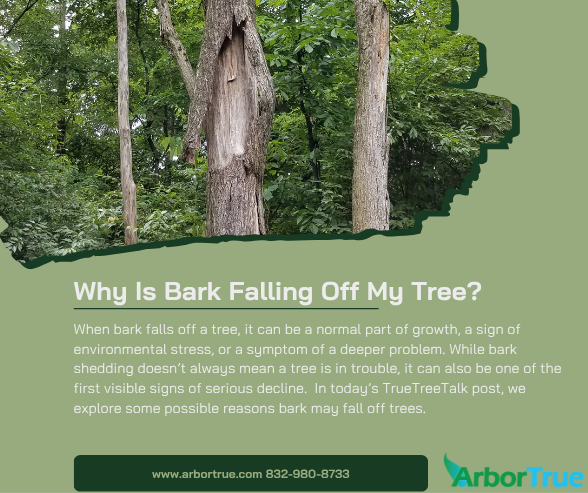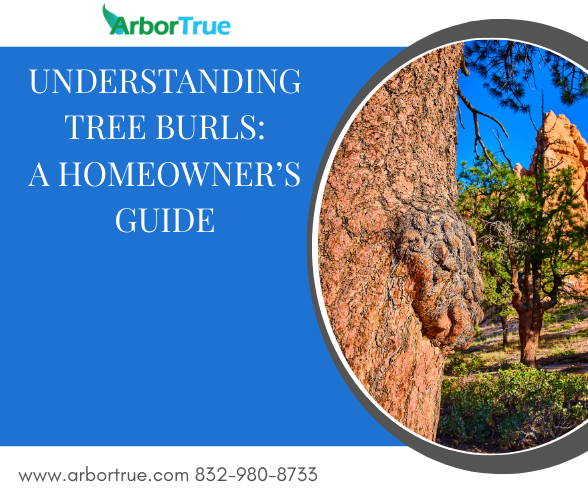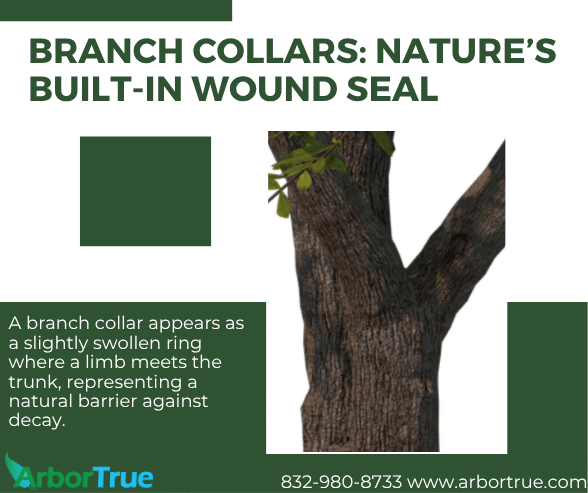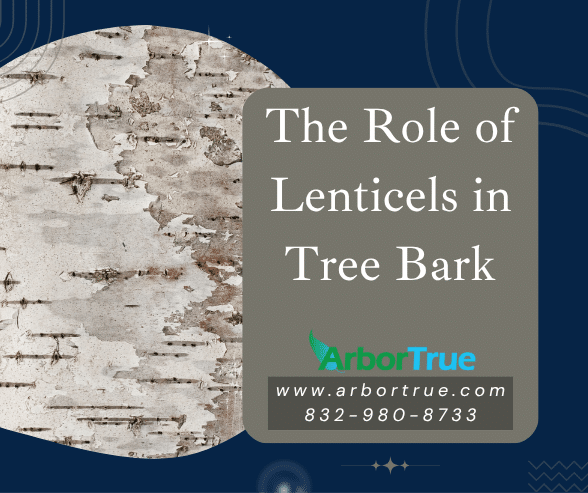
Mushroom Monday: The Prince (Agaricus augustus)
July 7, 2025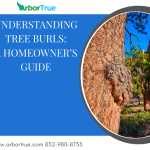
Understanding Tree Burls: A Homeowner’s Guide
July 11, 2025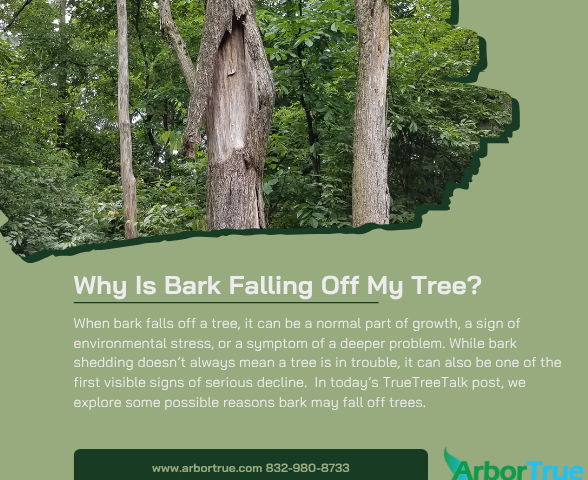
Why Is Bark Falling Off My Tree?
Sloughing, peeling, or flaking bark is easy to spot—but not always easy to understand. When bark falls off a tree, it can be a normal part of growth, a sign of environmental stress, or a symptom of a deeper problem. While bark shedding doesn’t always mean a tree is in trouble, it can also be one of the first visible signs of serious decline.
In today’s TrueTreeTalk post, we explore some possible reasons bark may fall off trees. This is not a comprehensive list, and bark loss is best assessed by a qualified arborist. If you’re seeing exposed wood or strips of bark on the ground, it’s time to schedule an inspection.
Trees That Naturally Shed Bark
Some tree species naturally slough off bark as they grow. River birch, sycamore, and crepe myrtle, among others, are known for this trait. In these trees, exfoliating bark is normal and part of a healthy cycle of outer bark being replaced by new layers beneath.
In these cases, the underlying wood is typically uninjured, and the tree continues to leaf out and grow as expected. The pattern may be patchy or dramatic, but it’s not cause for concern if the tree appears otherwise healthy.
Sunscald and Heat Stress
Sudden or prolonged exposure to sunlight can damage tree bark, especially on thin-barked species. This damage, often referred to as sunscald, typically appears on the south or southwest side of the trunk. High temperatures can kill the living tissues beneath the bark, leading to peeling, cracking, or sunken areas.
In some cases, the bark may fall off in sheets, revealing dry, brittle wood beneath. Heat-related bark loss is often more noticeable following periods of drought, which increase the tree’s vulnerability to injury.
Frost Cracks and Winter Injury
Rapid temperature drops in winter can also cause damage beneath the bark. This thermal stress can lead to vertical splits or cracks, known as frost cracks. As moisture within the wood freezes and expands, pressure builds, and the bark may loosen or split away from the trunk.
These injuries often appear suddenly but may take weeks or months to result in noticeable bark loss. Trees that survive a winter injury may continue to grow but could be vulnerable to decay fungi and insect pests at the damaged site.
Insect or Disease Activity
Many tree pests enter a tree by boring through the bark. Once inside, they may feed on the inner layers of the trunk or introduce pathogens that disrupt the flow of nutrients. Over time, bark may loosen or fall away as the wood dies underneath.
Wood-boring beetles, fungal cankers, and certain bacterial diseases can all cause bark to slough off in affected areas. The presence of small holes, dark staining, oozing sap, or sawdust-like frass near peeling bark may point to pest or disease activity.
Proper diagnosis is essential in these cases. At ArborTrue, our qualified arborists can examine bark damage and recommend the next best step for protecting your tree.
Drought Stress and Root Issues
When trees experience drought stress or root damage, the first signs often appear above ground. Reduced water uptake can cause the outer bark to dry and contract, eventually leading to cracking or flaking. In some cases, bark loss reflects long-term stress that’s also affecting canopy health or new growth.
Root disturbance from construction, poor soil drainage, or girdling roots can have similar effects. While the bark may peel slowly or appear papery, the underlying problem is often more serious.
Mechanical Damage or Physical Injury
Impact from lawn equipment, vehicles, or even animals can damage bark and lead to localized sloughing. These wounds may heal over time—or they may allow pathogens or insects to enter, worsening the injury.
Wounds that girdle a large portion of the trunk or are slow to close may compromise the tree’s vascular system. Early detection can help, but in these cases it’s especially important to have a professional evaluation.
Is Bark Loss Always a Problem?
Not always—but it’s also not something to ignore. Trees may shed bark as a natural part of growth, or they may lose bark as a result of injury, disease, or stress. What matters most is the context. Is the tree otherwise healthy? Are new leaves emerging on schedule? Is there sap leakage, dieback, or discoloration?
Because bark loss can be caused by many overlapping factors, a full inspection by a qualified arborist is the only way to determine what’s really going on. An expert can examine not only the trunk but also the canopy, root flare, and soil conditions.
Call an Arborist if You See Bark Falling Off
At ArborTrue, we specialize in diagnosing tree health issues, including those that may start beneath the bark. If your tree is shedding bark, don’t wait until more symptoms appear. Our qualified arborists can determine whether what you’re seeing is a normal growth pattern—or a sign of trouble that needs to be addressed.
Conclusion
Bark sloughing can happen for many reasons. In some trees, it’s completely normal. In others, it may indicate a deeper issue. This post is not a complete guide to bark problems, but it highlights several of the more common possibilities. If your tree is losing bark, schedule a visit with ArborTrue today. We can help you understand what your tree is telling you—before it’s too late.
If you found this information about bark falling off helpful, check out our other posts on our TrueTreeTalk blog. Follow us on Facebook to keep up with these and other posts. Check out our list of blog posts grouped by topic for more to read. Also, follow us on LinkedIn for industry-related posts. We also had a post about cracks in bark that you may find interesting.
* * *
ArborTrue is a science-based tree service company in the greater Houston area. We also serve Austin and other parts of Central Texas. We provide a range of services including tree trimming, tree pruning, tree removal, tree planting, arborist consultations, and more. Call us today at 832-980-8733 (Houston) or at 512-546-3833 (Austin) or reach out to us online to schedule an appointment.
ArborTrue has a dedicated landscaping division, now serving select areas in the greater Houston region—with more locations coming soon. We specialize in organic practices, soil biology, and ecological health to help your entire landscape truly thrive. To learn more or schedule a consultation, contact us at landscape@arbortrue.com.

